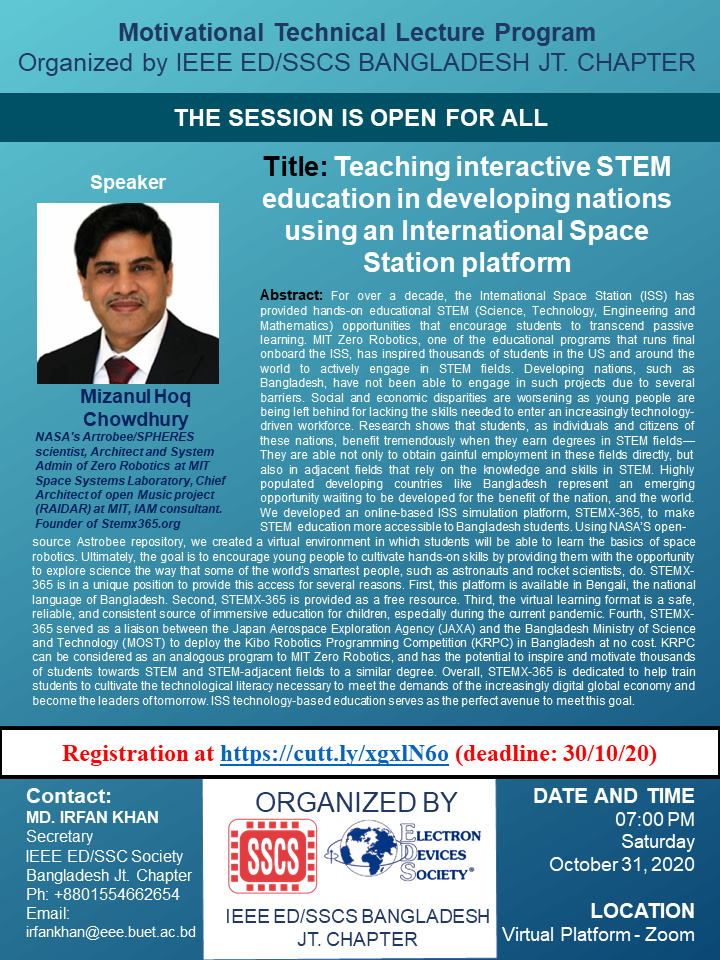Motivational Technical Lecture Program on "Teaching interactive STEM education in developing nations using an International Space Station platform" by Mizanul Hoq Chowdhury

A Motivational Technical Lecture Program Organized by IEEE Electron Devices and Solid State Circuit Society Bangladesh Chapter. Your participation in this event is highly appreciated.
Date and Time
Location
Hosts
Registration
-
 Add Event to Calendar
Add Event to Calendar
Loading virtual attendance info...
Speakers
 Mizanul Hoq Chowdhury, NASA's Artrobee/SPHERES scientist, Architect and System Admin of Zero Robotics at MIT Space Systems Laboratory, Chief Architect of open Music project (RAIDAR) at MIT, IAM consultant. Founder of Stemx365.org
Mizanul Hoq Chowdhury, NASA's Artrobee/SPHERES scientist, Architect and System Admin of Zero Robotics at MIT Space Systems Laboratory, Chief Architect of open Music project (RAIDAR) at MIT, IAM consultant. Founder of Stemx365.org
Teaching interactive STEM education in developing nations using an International Space Station platform
For over a decade, the International Space Station (ISS) has provided hands-on educational STEM (Science, Technology, Engineering and Mathematics) opportunities that encourage students to transcend passive learning. MIT Zero Robotics, one of the educational programs that runs final onboard the ISS, has inspired thousands of students in the US and around the world to actively engage in STEM fields. Developing nations, such as Bangladesh, have not been able to engage in such projects due to several barriers. Social and economic disparities are worsening as young people are being left behind for lacking the skills needed to enter an increasingly technology-driven workforce. Research shows that students, as individuals and citizens of these nations, benefit tremendously when they earn degrees in STEM fields—They are able not only to obtain gainful employment in these fields directly, but also in adjacent fields that rely on the knowledge and skills in STEM. Highly populated developing countries like Bangladesh represent an emerging opportunity waiting to be developed for the benefit of the nation, and the world. We developed an online-based ISS simulation platform, STEMX-365, to make STEM education more accessible to Bangladesh students. Using NASA’S open-
source Astrobee repository, we created a virtual environment in which students will be able to learn the basics of space robotics. Ultimately, the goal is to encourage young people to cultivate hands-on skills by providing them with the opportunity to explore science the way that some of the world’s smartest people, such as astronauts and rocket scientists, do. STEMX-365 is in a unique position to provide this access for several reasons. First, this platform is available in Bengali, the national language of Bangladesh. Second, STEMX-365 is provided as a free resource. Third, the virtual learning format is a safe, reliable, and consistent source of immersive education for children, especially during the current pandemic. Fourth, STEMX-365 served as a liaison between the Japan Aerospace Exploration Agency (JAXA) and the Bangladesh Ministry of Science and Technology (MOST) to deploy the Kibo Robotics Programming Competition (KRPC) in Bangladesh at no cost. KRPC can be considered as an analogous program to MIT Zero Robotics, and has the potential to inspire and motivate thousands of students towards STEM and STEM-adjacent fields to a similar degree. Overall, STEMX-365 is dedicated to help train students to cultivate the technological literacy necessary to meet the demands of the increasingly digital global economy and become the leaders of tomorrow. ISS technology-based education serves as the perfect avenue to meet this goal.
Biography:
Mizan Chowdhury is involved in overall system design, operations and architecture of
the Zero Robotics (ZR) space project at MIT Space Systems Laboratory in the Aero
Astro Department. He is the “brains” behind the operation of the ZR project. The ZR
project uses a backend simulation system to process millions of simulations requests/hr.
Due to design flaws, the simulation system used to freeze every single day, and its
maintenance became very costly and time consuming. Mizan was able to solve this
problem successfully after troubleshooting and extensive research. He then proposed,
designed, and implemented a new online virtual Integrated Development Environment
(IDE) and Visualization system. This streamlined environment helped the ZR team to
run almost 90% of the operations on the ground and 10% inside the ISS, reducing costs
tremendously. Currently, Mizan is assisting the MIT Astrobee team in automation of the
overall development, integration, testing and deployment of Astrobee hardware and
software. He is also helping students and researchers in writing algorithms, creating
simulations, visualizations, and much more. Mizan is also involved developing STEMX-
365 using NASA’s open source repository. Recently, Mizan introduced Bangladesh in JAXA’s
Kibo ABC program. It is a great opportunity for Bangladesh. With this Bangladesh students
participated Kibo-RPC, which is Astrobee robotics programming competition onboard ISS and
also AHiS (Asian Herb in Space) project.

